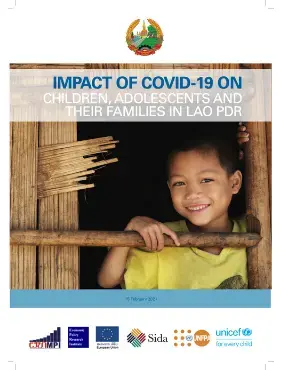The COVID-19 pandemic first emerged as a health crisis but has rapidly evolved into a global crisis, threatening survival – economically, socially, politically and epidemiologically – with grave consequences for human development, economic stability and sustenance. In Lao PDR, soon after the first case of COVID-19 was reported in March 2020, the government swiftly implemented a nationwide lockdown which was gradually lifted from mid-May. As a result, the epidemiological impact of the pandemic on Lao PDR has not been severe. The impact of the pandemic in Lao has been predominantly socioeconomic due to the breakdown in domestic and regional supply chains, business closures, livelihood disruptions and income losses.
Overall, the pandemic has “seriously affected Vientiane’s development objectives, exacerbated existing vulnerabilities and disrupted progress towards smooth graduation from least developed country status,” according to the Prime Minister’s address during the United Nations General Assembly plenary on 3 December 2020. The impact of the crisis has been unprecedented and governments around the world are navigating important choices, thinking through the contours of the new normal. More caveats, assumptions and speculations feed into every policy choice, which will affect the rate of economic recovery and rebound.
This report estimates the potential effect of COVID-19 on socioeconomic indicators of interest in Lao PDR along with secondary data sources, existing data and information to identify the risk drivers through a review of relevant literature from Lao PDR and globally. This document explores the cost of inaction and the benefits of action that the Government of Lao PDR can realise as part of its response towards the COVID-19 pandemic.
The analysis is based on microsimulation estimates of the socioeconomic impact of the pandemic in Lao PDR based on different mitigation scenarios. Without adequate action, the pandemic can have imminent as well as long-term socioeconomic effects across multiple dimensions such as food security, poverty, health, education, etc. with intergenerational reverberations. This provides an impetus for the Government of Lao PDR to make intersectoral investments which will contribute to economic, social and human development in the country amid the crisis.
This paper is structured as follows: Section 1 presents a snapshot of the data and methodological framework used in determining the socioeconomic impact of COVID-19 in Lao. Section 2 presents the impact in Lao PDR of COVID-19 on the dimensions of livelihoods, poverty, food insecurity, health, education, child marriage, child labour, child violence and, ultimately, how all these risks interact with climate threats in the context of the country. The results focus on both quantifiable socioeconomic indicators and issues that COVID-19 can either exacerbate directly and/or exploit as a result of implicit structural vulnerabilities. This is followed by concluding remarks.
This microsimulation analysis complements the Lao PDR risk report, both of which were commissioned in May 2020 when the COVID-19 crisis was still unfolding. Hence, the assumptions reflect the most accurate suppositions based on the intensity and duration surrounding the pandemic at that point in time. However, as the pandemic has progressed during the year, some of these assumptions have been modified. For instance, in early 2020, the impact of the crisis was expected to be far more severe for Lao PDR and the East Asia and Pacific region. However, swift and timely NPI responses in the region have mitigated the worst of the health shocks and, as a result, allowed for a gradual re-opening of the regional economy.
Consequently, Lao PDR and neighbouring countries have managed to minimise the socioeconomic impact of the crisis, particularly on education for children and on health care systems. Therefore, several of the initially modelled impacts, which reflect the initial globally accepted assumptions about the trajectory of the crisis but do not adequately reflect how the crisis has unfolded in Lao PDR, have been moved from the main report into the annex.


